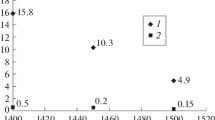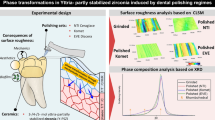Abstract
Ceramics based on partially stabilized zirconium dioxide are widely used in dentistry. The surface of a ceramic product is subjected to aerodynamic abrasive processing for reliable durable fixing before applying polymer cement. The mechanical properties of a machined thin ceramic layer are largely determined by its phase composition. The method of X-ray phase analysis is used to study the effect of aerodynamic abrasive treatment on the phase state of the surface layers of partially stabilized zirconium dioxide, depending on the type and conditions of formation of the developed microrelief. It is found that aerodynamic abrasive treatment is accompanied by a change in the initial phase composition, i.e., the appearance of a new monoclinic phase. The monoclinic phase is shown to be removed during thermal annealing at a temperature of no less than 1000°C. As an alternative to aerodynamic abrasive treatment prior to the application of polymer cement, it is proposed that the bonded surface be treated with a high-current pulsed beam of low-energy electrons. Such processing creates a developed surface microrelief without introducing a monoclinic phase in it.



Similar content being viewed by others
REFERENCES
R. C. Garvie, R. H. Hannink, and R. T. Pascoe, in Sintering Key Papers, Ed. by S. Somiya and Y. Moriyoshi (Springer, Dordrecht, 1990), p. 253. https://doi.org/10.1007/978-94-009-0741-6_14
I. Nettleship and R. Stevens, Int. J. High Technol. Ceram. 3, 1 (1987).
B. Stawarczyk, C. Keul, M. Eichberger, D. Figge, D. Edelhoff, and N. Lumkemann, Quintessence Int. 48, 369 (2017). https://doi.org/10.3290/j.qi.a38057
S. Tailor and M. Singh, J. Cluster Sci. 27, 1097 (2016). https://doi.org/10.1007/s10876-016-1014-y
T. A. G. Restivo, M. Durazzo, S. R. H. de Mello-Castanho, et al., J. Therm. Anal. Calorim. 131, 249 (2018). https://doi.org/10.1007/s10973-017-6560-5
M. Taheri, M. Mazaheri, F. Golestani-Fard, H. Rezaie, and R. Schaller, Ceram. Int. 40, 3347 (2014). https://doi.org/10.1016/j.ceramint.2013.09.098
D. Špehar and M. Jakovac, Acta Stomatol. Croat. 49, 137 (2015). https://doi.org/10.15644/asc49/2/7
M. Özcan and C. A. M. Volpato, Curr. Oral Health Rep. 2, 190 (2015). https://doi.org/10.1007/s40496-015-0071-x
G. Oilo and K. D. Jorgensen, J. Oral Rehabil. 5, 377 (1978). https://doi.org/10.1111/j.1365-2842.1978.tb01257.x
M. Inokoshi, J. De Munck, S. Minakuchi, and B. Van Meerbeek, J. Dent. Res. 93, 329 (2014). https://doi.org/10.1177/0022034514524228
M. B. Blatz, M. Vonderheide, and J. Conejo, J. Dental Res. 97, 132 (2018). https://doi.org/10.1177/0022034517729134
O. Y. Kurapova, A. G. Glukharev, O. V. Glumov, M. Y. Kurapov, E. V. Boltynjuk, and V. G. Konakov, Electrochim. Acta 320, 134573 (2019). https://doi.org/10.1016/j.electacta.2019.134573
D. R. R. Lazar, M. C. Bottino, M. Özcan, et al., Dental Mater. 24, 1676 (2008). https://doi.org/10.1016/j.dental.2008.04.002
T. S. Frangulyan, I. P. Vasil’ev, and S. A. Ghyngazov, Ceram. Int. 44, 2501 (2018). https://doi.org/10.1016/j.ceramint.2017.10.234
A. P. Surzhikov, T. S. Frangulyan, S. A. Ghyngazov, and I. P. Vasil’ev, Tech. Phys. Lett. 40, 762 (2014). https://doi.org/10.1134/S1063785014090144
D. Zaguliaev, V. Gromov, Y. Rubannikova, S. Konovalov, Y. Ivanov, D. Romanov, and A. Semin, Surf. Coat. Technol. 383, 125246 (2020). https://doi.org/10.1016/j.surfcoat.2019.125246
Funding
This work was financially supported by the Ministry of Science and Higher Education of the Russian Federation within the framework of the state assignment “Science” and a grant under the Program for increasing the competitiveness of Tomsk Polytechnic University.
Author information
Authors and Affiliations
Corresponding author
Rights and permissions
About this article
Cite this article
Ghyngazov, S.A. Influence of Aerodynamic Abrasive Treatment on the Phase State of the Surface Layer of Ceramics of Partially Stabilized Zirconium Dioxide. J. Surf. Investig. 15, 592–595 (2021). https://doi.org/10.1134/S1027451021030265
Received:
Revised:
Accepted:
Published:
Issue Date:
DOI: https://doi.org/10.1134/S1027451021030265




